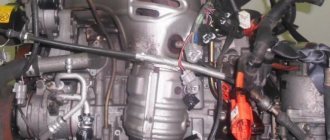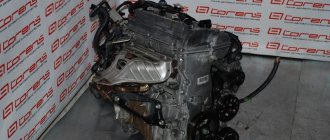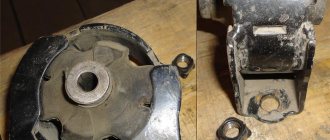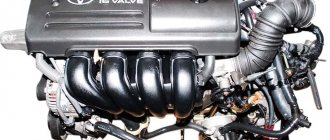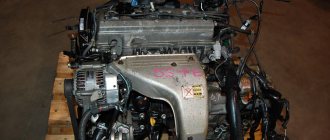Toyota S-series engines are simple in-line fours with a displacement of 1.8 to 2.2 liters, which were produced from 1980 to 2007. 27 years! Production of most versions was curtailed by 2002, and after that only a few turbocharged and highly boosted 2-liter modifications were in production.
The 3S-FE engine, which we will disassemble, appeared in 1986 on the Toyota Camry and survived until the first generation Avensis. This engine has a cast-iron cylinder block, an aluminum cylinder head, which has 16 valves without hydraulic compensators in their drive. The timing drive uses a timing belt that drives only the intake camshaft, while the exhaust camshaft is driven by a gear drive.
On our YouTube channel you can watch a disassembly of a 2-liter 3S-FE engine removed from a 2000 Toyota RAV4.
You can select and buy an engine for Toyota in our catalog of contract engines.
Toyota 3S-FE engine reliability
The 3S engine is very simple and reliable, but is noisy in operation and has a slight oil appetite. He really has no weak points. With normal maintenance and timely oil changes, it will easily cover more than 500,000 km.
However, the service life of the 3S-FE engines, which entered production in August 1996, is worse. These engines received lightweight pistons and connecting rods, and the crankshaft remained the same, model 1988. We will tell you more about this later.
Throttle valve and idle air valve
The throttle valve of the 3S-FE engine has a cable drive and, on later versions, a throttle position sensor. An electronic idle speed controller is used to keep the engine idling. Let us remember that thanks to it, when the mechanical damper is completely closed, the air required by the engine to idle goes bypassing the damper through the idle air control channel.
Idle problems on a 3S-FE engine are usually resolved by cleaning the governor.
The throttle valve on this engine becomes contaminated with oil vapor and soot. Oil vapors in the intake appear due to the crankcase ventilation system not screening them out very effectively. And the source of soot is the EGR system. After cleaning the throttle body, the engine response becomes noticeably livelier.
You can select and buy a throttle valve for a Toyota engine in our catalog of contract spare parts.
Dual ignition coils
Since August 1996, the ignition system on the 3S-FE engine has been modernized. Instead of a distributor, two double ignition coils were installed, that is, each coil serves two spark plugs. Thus, each spark plug produces a spark twice during 4 working cycles. Consequently, the load on spark plugs and high-voltage wires is higher.
In practice, this turned out to be the case: compared to a system with a distributor, the coil ignition on the 3S-FE engine required twice as much attention. That is, if previously high-voltage wires served for more than 10 years, then when paired with these coils, their service life was reduced to 5-6 years. And the coils themselves turned out to be not so durable compared to the mechanical ignition distributor.
You can select and buy ignition coils for a Toyota engine in our catalog of contract spare parts.
Disassembly
Disassembly is the initial stage of adjusting the 3S-FE valve clearances. The first step is to disconnect the negative battery terminal cable and high-voltage wires. Then the accelerator cable and, in the case of an automatic transmission, the throttle control cable are disconnected. Having dismantled the accelerator cable bracket, disconnect the hoses of the crankcase ventilation system. Next, you should dismantle the cylinder head cover, as well as the gasket, for which you need to unscrew the four nuts and get rid of the spark plug tubes. The seals must be placed in the exact sequence in which they are disconnected in order to prevent leakage of fuels and lubricants.
Required manual excerpt
EGR system
The EGR system has been used on the 3S-FE engine from the very beginning. The system operates in three modes, focusing on temperature and engine load. There is no exhaust gas recirculation until operating temperature is reached, or at full throttle (maximum load). At low loads (i.e. leisurely driving), gas recirculation is small. The maximum flow of exhaust gases into the intake occurs at an average load and constant speed (for example, when driving on a highway).
An electrovacuum valve is used for flexible recirculation control. It controls the EGR valve not directly, but through a vacuum modulator - this is essentially a housing in a membrane. Vacuum opens the EGR valve and pressure closes it. Those. By default the EGR valve is closed.
Most often, in this system on a 3S-FE engine, the vacuum valve fails. Because of this, the engine begins to work hard, i.e. detonate at medium loads in the range from 1500 to 2500 rpm. Those. Exhaust gases are not supplied to the intake, which causes the combustion temperature of the fuel-air mixture to greatly increase.
The vacuum valve (located at the bottom of the intake manifold) can be checked for electrical resistance: the values should be from 33 to 39 ohms.
To check, you need to “blow out” the modulator. When the engine is not running and up to 2500 rpm, it is blown “through and through”, i.e. air will exit through ports P and R. At engine speeds greater than 2500 rpm, air should not pass through the modulator.
The EGR valve is checked with the engine running. To do this, you need to disconnect the tube on the valve, connect a manual vacuum pump instead and create a vacuum. If, as the vacuum at input Q increases, the engine begins to operate unstably and even stalls, then all components are working properly.
There is also a filter in the vacuum modulator housing, through which tiny portions of exhaust gases that reach it through the tube pass through and are “cleaned” when the EGR valve closes. This filter needs to be cleaned every couple of years; just compressed air is good for cleaning.
Injectors
Clogged fuel injectors cause the 3S-FE engine to start unsteadily when cold or hot. Replacing them solves startup problems.
You can select and buy gasoline injectors and a fuel rail for a Toyota engine in our catalog of contract spare parts.
Required Tools
Adjustment of 3S-FE valves is impossible without previously prepared tools. To carry out the work you will need the following tools:
Micrometer
- micrometer;
- a set of styli, especially those with smaller pitches are of interest;
- tweezers with a curved tip;
- adjusting washers;
- screwdriver;
- flashlight.
Before starting work, remember that the car engine must be cold to accurately measure and adjust the gap.
Set of probes
Crankcase ventilation
The crankcase ventilation system of the 3S-FE engine is not very diligent in sifting oil vapors from gases. Therefore, oil vapors settle in the intake manifold and on the throttle valve. To capture oil vapors, some owners install an external oil separator, or even 2 oil separators.
The standard oil separator in the form of a labyrinth is located in the valve cover. Crankcase gases from it are sent to the intake through two channels - before and after the throttle valve. When there are heavy deposits in the labyrinth, oil sifting practically stops, so the engine has an oil appetite: i.e. it “consumes” oil vapors entering the intake manifold. It is also a good idea to check the check valve in the gas supply tube behind the throttle valve. It may need cleaning, or better yet, replacement.
Repair
Basically, repairs require cleaning the entire mechanism, because it is precisely because of the large amount of soot accumulated on the walls that usually leads to the damper getting stuck, causing a breakdown. In this case, cleaning should be carried out on all components of both the throttle valve and the manifold.
Before starting dismantling work to remove the Toyota Corolla throttle valve, the engine must be cold or cooled down. This is due to the heating of the damper body itself, because it is in direct contact with the intake manifold and heats up intensely during operation.
Oil in spark plug wells
There are cases of oil getting into spark plug wells. In this case, misfires occur, i.e. The engine is unstable, almost stalls at idle and loses a lot of power. When you unscrew the spark plugs, you discover that they are filled with oil.
Oil enters the wells through their lower threads. The spark plug wells on the 3S engine, as on many gasoline engines, are tubes screwed into the cylinder head above the spark plug channel.
To combat oil ingress, it is necessary to unscrew the tubes and place them on new thread sealant.
You can select and buy a cylinder head for a Toyota engine in our catalog of contract spare parts.
Adjustment of valves
Thermal clearances of valves are adjusted by selecting washers installed on disc pushers. Each original washer costs about $9. But today there are enough substitutes on the market. In addition, washers from many other engines are suitable here, incl. from licensed Geely units. The diameter of such washers is very common - 28 mm.
Owners come to adjust thermal clearances when a characteristic clicking sound of valves appears when the engine is running.
I show what will happen to valve washers from VAZ on TOYOTA
Good time everyone!
I have a Toyota Mark 2 car, I’ve owned it for almost 10 years, during which time I had to deal with adjusting the thermal valve clearances. The measurement results showed that adjustment of the intake valves was required. (My original washers were polished and they began to knock) And then the question arose of purchasing washers, the original ones at that time cost from 300 rubles per piece, but about 9 pieces were needed. (they are 25mm in diameter) But the thought of remaking VAZ washers from 2108 (they are 31mm in diameter) haunted me. Cost 60r/piece.
I picked up four pieces from my family, swapped places, and needed 5 more pieces. But the main problem was not even the money, but the fact that they were only made to order - a week or more, but the car was needed, I didn’t want to put it back together and then take it apart again, especially since anyone who pulled out the washers knows how abusive it is to do. ))) (without removing the camshafts).
I read a lot of reviews, listened to the opinions of “experts” that the metal of the washers is weak, wrinkles, breaks, etc., and will not work on a Toyota. But nevertheless I decided and took it. They refused to reduce the diameter of the turner, so I decided to grind it myself using sandpaper and, surprisingly, it turned out very well:
I adjusted all the gaps to tolerances and assembled everything.
After driving it for several years, I decided to open it up, see how the washers feel and at the same time check the gaps.
The moment of pulling out the washers was a little nervous, but after taking out a few ground washers, the worries dissipated!
Source
Connecting rod and piston group
Since the end of 1996, 3S-FE engines have been produced with lightweight pistons and connecting rods. The connecting rod and piston group lost about 740 grams. But the crankshaft remained the same, i.e. They did not revise the balancing of the crank mechanism.
The connecting rods of the 96 sample are thinner, and the pistons are lightened by giving them a T-shaped profile. We can also pay attention to the pressed-in, rather than floating, piston pins and the halved number of holes for draining oil from the oil ring grooves.
The height of the rings has also been reduced. Compression rings decreased from 1.5 to 1.2 mm, and oil scraper rings from 4 to 3 mm. Although the pistons of the 3S-FE engine of the 1996 model are still very far from the modern “tablet” profile.
In general, we will not criticize the design of these pistons too much. In practice, they do not create serious problems. But their oil scraper rings are more sensitive to coking. It happens that he comes to pour decoking into the cylinders, and this helps.
Connecting rod bolts
The connecting rod bolt numbers for the 3S-FE engine have not changed since 1994. But from 1996 to 2001, these engines suffered from insufficiently strong connecting rod bolts. They came off on their caps. This happened both during re-tightening and during operation. As a rule, after repairs involving the removal and installation of connecting rod caps on old bolts. It is now known that the Japanese replaced the connecting rod bolts with durable ones during the recall campaign. In general, when removing and installing connecting rod caps on a 3S-FE engine, a complete replacement of the connecting rod bolts is highly recommended.
You can choose and buy an engine for Toyota RAV4, Toyota Avensis or Toyota Auris, Toyota Yaris in our catalog of contract engines.
Here, using the links, you can see the availability of specific Toyota cars at the dismantling station and order auto parts from them.
Assembly
Reassembly begins with installing the cylinder head cover. First you need to get rid of the old seal and apply sealant to the cylinder head. Then we install the cylinder head gasket and cover, as well as four spark plug tube seals. We tighten the nuts with a torque of 23 Nm.
Next, we connect the hoses of the crankcase ventilation system 3S-FE and the accelerator cable bracket. Next, we return the throttle control cable to its place if the car is equipped with an automatic transmission. Having connected the accelerator cable and high-voltage wires, we connect the battery.

